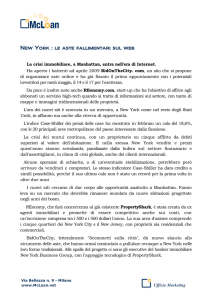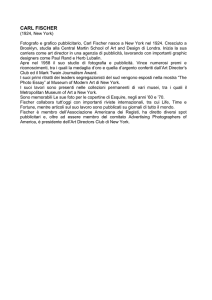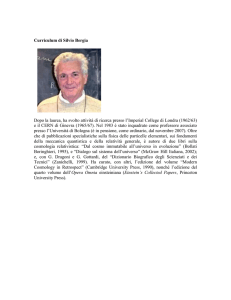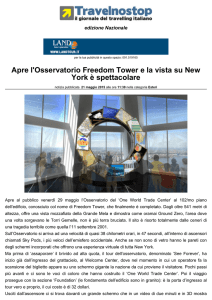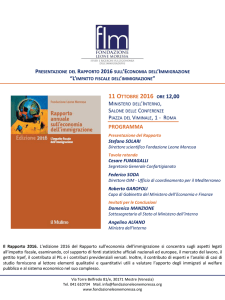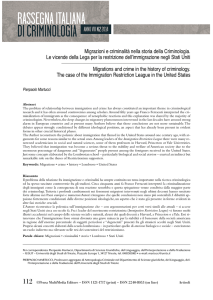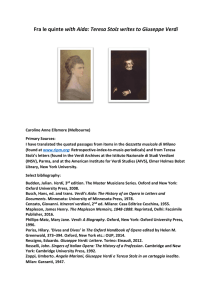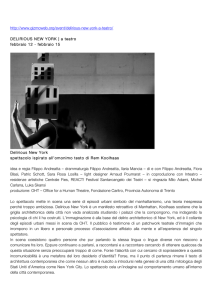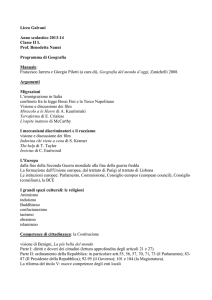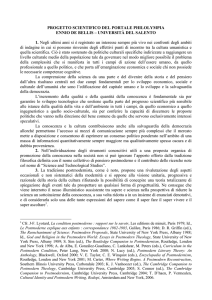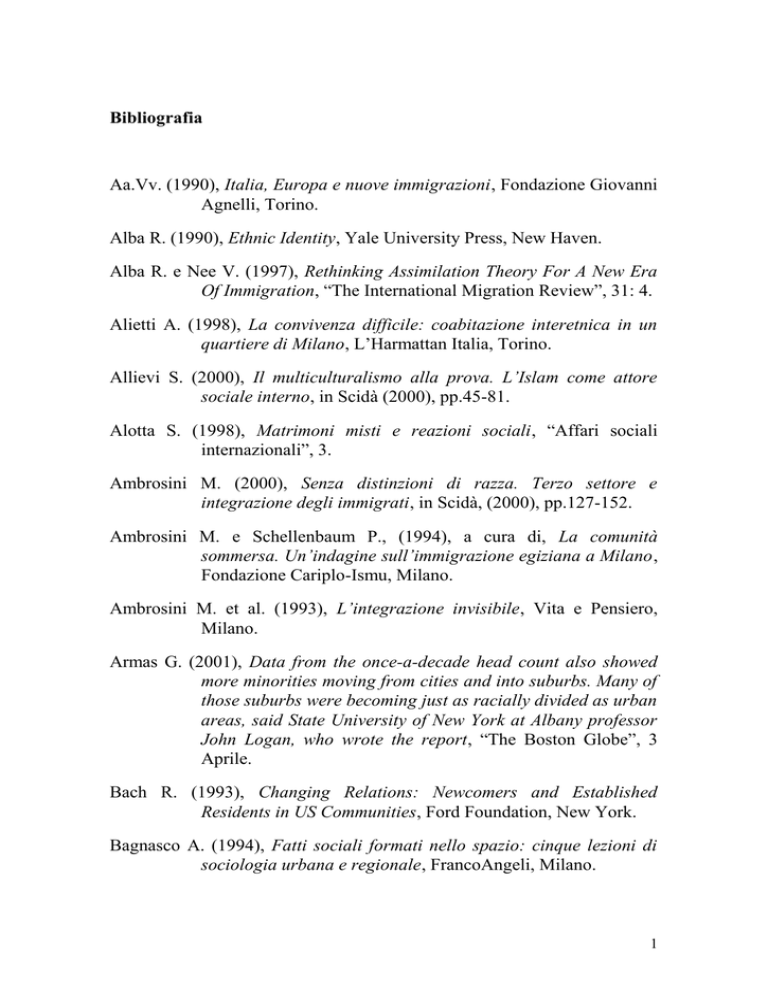
Bibliografia
Aa.Vv. (1990), Italia, Europa e nuove immigrazioni, Fondazione Giovanni
Agnelli, Torino.
Alba R. (1990), Ethnic Identity, Yale University Press, New Haven.
Alba R. e Nee V. (1997), Rethinking Assimilation Theory For A New Era
Of Immigration, “The International Migration Review”, 31: 4.
Alietti A. (1998), La convivenza difficile: coabitazione interetnica in un
quartiere di Milano, L’Harmattan Italia, Torino.
Allievi S. (2000), Il multiculturalismo alla prova. L’Islam come attore
sociale interno, in Scidà (2000), pp.45-81.
Alotta S. (1998), Matrimoni misti e reazioni sociali, “Affari sociali
internazionali”, 3.
Ambrosini M. (2000), Senza distinzioni di razza. Terzo settore e
integrazione degli immigrati, in Scidà, (2000), pp.127-152.
Ambrosini M. e Schellenbaum P., (1994), a cura di, La comunità
sommersa. Un’indagine sull’immigrazione egiziana a Milano,
Fondazione Cariplo-Ismu, Milano.
Ambrosini M. et al. (1993), L’integrazione invisibile, Vita e Pensiero,
Milano.
Armas G. (2001), Data from the once-a-decade head count also showed
more minorities moving from cities and into suburbs. Many of
those suburbs were becoming just as racially divided as urban
areas, said State University of New York at Albany professor
John Logan, who wrote the report, “The Boston Globe”, 3
Aprile.
Bach R. (1993), Changing Relations: Newcomers and Established
Residents in US Communities, Ford Foundation, New York.
Bagnasco A. (1994), Fatti sociali formati nello spazio: cinque lezioni di
sociologia urbana e regionale, FrancoAngeli, Milano.
1
Bagnasco A. e Le Galès Patrick (2000), a cura di, Cities in Contemporary
Europe, Cambridge University Press, Cambridge.
Balbo L. e Manconi L. (1992), I razzismi reali, Feltrinelli, Milano.
Banton M. (1983), Racial and Ethnic Competition, Cambridge University
Press, Cambridge.
Barth F. (1969), Ethnic Groups and Boundaries. The Social Organization
of Cultural Differences, Allen & Unwin, London.
Bastenier A. e Dassetto F. (1990), Nodi conflittuali conseguenti
all’insediamento definitivo delle popolazioni immigrate nei
paesi europei, in Aa.Vv. (1990), pp.3-64.
Bastenier A. e Dassetto F. (1993), Immigration et Espace Public: la
controverse de l’integration, L’Harmattan, Paris.
Bauman Z. (2001), Voglia di comunità, Laterza, Bari.
Belsie L.(2001), Yet despite this evidence of America's increasing ethnic
variety, the view from neighborhoods remains stubbornly
segregated, “The Christian Science Monitor”, 14 Marzo.
Bernach L. e Sussi E. (1993), a cura di, Minoranze etniche ed emigrazione.
La sfida del pluralismo culturale, Angeli, Milano.
Bernardi U. (1992), L’insalatiera etnica. Società multiculturale e relazioni
interetniche, Neri Pozza, Vicenza.
Berti F. (2000), Esclusione e integrazione, FrancoAngeli, Milano.
Blanc M. e Le Bars S. (1993), Les minorités dans la cité: perspectives
comparatives, L’Harmattan Logiques Sociales, Paris.
Boeckler S. (1997), Il discorso sull’etnicità nelle scienze sociali italiane e
tedesche, “Studi Emigrazione”, 34: 125.
Bolaffi G. (2001), I confini del patto, Einaudi, Torino.
Booth
W.
(1998), One Nation Indivisible:
<<http://www.washingtonpost.com>>.
Is
It
History?,
2
Brimelow P. (1996), Alien Nation: Common Sense About America’s
Immigration Disaster, Paperback, New York.
Brusa C. (1997), a cura di, Immigrazione e multicultura nell’Italia di oggi,
ISMU, Franco Angeli, Milano.
Bullard R.D., Grigsby J.E. III e Lee C. (1994), Residential Apartheid: the
American Legacy, CAAS Publications, University of
California, Los Angeles.
Burgalassi S. e Biancheri R. (1995), a cura di, Appartenenza e identità,
ETS, Pisa.
Burguière A. e Grew R. (2001), The Construction of Minorities, The
University of Michigan Press, Ann Arbor.
Bush M. e Mullings A. (1996), Race, Ethnicity and Community in
Brooklyn: An Annotated Bibliography, Brooklyn College
(CUNY), New York.
Calvanese F. (1993), Nuovi modelli migratori: il caso italiano, in Delle
Donne, Melotti., Petilli (1993), pp.173-184.
Campani G., Carchedi F., Tassinari A. (1994), a cura di, L’immigrazione
silenziosa. Le comunità cinesi in Italia, Fondazione Giovanni
Agnelli, Torino.
Caritas di Roma (2000), Immigrazione: Dossier statistico 2000, Roma,
Edizioni Anterem.
Caritas
di
Roma (2001) Anticipazioni del “Dossier
Immigrazione
2001”,
http://www.caritasroma.it/immigrazione >>
Statistico
<<
Carmon N. (1996), a cura di, Immigration and Integration in PostIndustrial Societies, Centre for Research in Ethnic Relations,
University of Warwick., Warwick.
Carter W. H. (1998), Polarisation, Public Housing And Racial Minorities
In US Cities, “Urban Studies”, 35: 10.
Castles S. (2000), Ethnicity and Globalization, Sage Publications, London.
Censis (1999), Le paure degli italiani, “Working Paper”, Roma.
3
Cesareo V. (1998), Società multietnica e multiculturalismo, “Studi di
Sociologia”, 4.
Cesareo V. (2000), Società multietniche e multiculturalismi, Vita e
Pensiero, Milano.
Cestim - Centro Studi Immigrazione (2000), Relazione finale del progetto
“Numero Verde Schengen...una telefonata contro la
discriminazione”, Verona, dicembre 1999 - ottobre 2000,
<<http:// www.cestim.org >>.
Champion A. G. (1994), International Migration And Demographic
Change In The Developed World, “Urban Studies”, 31: 4/5.
Chen D. W. (2001), Suburbs are changing in ways like the cities, and in a
way, are becoming more like cities certainly in their diversity,
“The New York Times”, 16 Marzo.
Chiozzi P. (1991), Antropologia urbana e relazioni interetniche: città
nuova, nuova città, Karta, Firenze.
Clark W.(1998), Mass Migration And Local Outcomes: Is International
Migration To The United States Creating A New Urban
Underclass?, “Urban Studies”, 35: 3.
CNN Italia (2001a), Segregazione residenziale come 30 anni fa. Il colore
continua a dividere l’America, << http://CNNitalia.it >>
CNN Italia (2001b), Usa, il melting pot per antonomasia. Ma i matrimoni
misti sono pochissimi, << http://CNNitalia.it >>
Cocchi G. (1990), a cura di, Stranieri in Italia. Caratteri e tendenze
dell’immigrazione dai paesi extracomunitari, Misure/Materiali di ricerca
dell’Istituto Cattaneo, Bologna.
Cohn V.(2001), Blacks and whites in New York are no more likely to share
neighborhoods than they were a decade ago, when New York
was one of the nation's most segregated cities, “The
Washington Post”, 16 Marzo.
Cohn-Bendit D., Schmid T. e Boeri, T. (1994), a cura di, Patria Babilonia:
il rischio della democrazia multiculturale, Teoria, Roma e
Napoli.
4
Conway D. e Cooke T. (1996), New York City: Caribbean Immigration
and Residential Segregation in a Restructured Global City, in
O’ Loughlin e Friedrichs (1996), pp.235-258.
Corbetta, P. (1999), Metodologia e Tecniche della Ricerca Sociale, Il
Mulino, Bologna.
Cotesta V. (1997), L’integrazione degli immigrati nella società italiana:
definizioni, teorie e modelli. Un approccio sociologico, in
Giorgi e Strozza (1996), pp.247-257.
Cotesta V. (1999), Sociologia dei conflitti etnici: razzismo, immigrazione e
società multiculturale, Editori Laterza, Bari.
Cotesta V.(1996), Nuovi conflitti metropolitani, “Annali di Sociologia”,
12: I-II
Crespi F. (1996), Mutamento sociale, identità e crisi della solidarietà, in
Crespi (a cura di), 1996, pp.3-9.
Crespi F. e Segatori R. (1996), a cura di, Multiculturalismo e democrazia,
Donzelli Editore, Roma.
Cross M. e Keith M. (1993), a cura di, Racism, the City and the State,
Routledge, London e New York.
Crosta P.L., Mariotto A., Tosi A. (2000), Immigrati, territorio e politiche
urbane. Il caso italiano, “Dossier di Ricerca per Migrazioni,
Scenari per il XXI Secolo”, Agenzia Romana per la
preparazione del Giubileo, Roma.
D’Eramo M. (2001), Le quasi-caste d’America, “Il Manifesto”, 18 Aprile.
Davico L. e Mela A. (1999), Aspetti spaziali dei nuovi fenomeni migratori
in Piemonte, “Sociologia urbana e rurale”, 59.
De Bernart M. (1994), Migrazioni, scienze sociali e politiche sociali. Il
caso italiano, “Annali di Sociologia”, 10: I-II.
De Rudder V.(1989), Le relazioni interetniche in situazione di
coabitazione, “La Critica Sociologica”, 89.
5
De Vos G. e Romanucci-Ross L. (1994), a cura di, Ethnic Identity:
Creation, Conflict And Accommodation, Altamira Press,
Walnut Creek, London.
Delle Donne M. (1998), a cura di, Relazioni Etniche: stereotipi e
pregiudizi. Fenomeno immigratorio ed esclusione sociale,
Ediup, Roma.
Delle Donne M. (2000), Convivenza civile e xenofobia, Feltrinelli, Milano.
Delle Donne M., Melotti U. e Petilli S. (1993), a cura di, Immigrazione in
Europa, Cediss, Roma.
DeSantis J. (1991), For the Color of his Skin: The Murder of Yusuf
Hawkins and the Trial of Bensonhurst, Pharos Books, New York.
DeSena J. (1990), Protecting one’s turf: social strategies for maintaining
urban neighborhood, University Press of America, Lanham, MD.
Dunn K. M. (1998), Rethinking Ethnic Concentration: The Case of
Cambramatta, Sydney, “Urban Studies”, 35: 3.
Ellis M. and R. Wright (1998), The Balkanization Metaphor In The
Analysis Of US Immigration, “Annals of the Association of
American Geographers”, 88.
Fabietti, (1995), L’identità etnica. Storia e critica di un concetto equivoco,
La Nuova Italia, Roma.
Fainstein (1993), Race, Class And Segregation: Discourses About African
Americans, “International Journal of Urban and Regional
Research”, 17.
Fainstein S. (1998), Assimilation And Exclusion In US Cities. The
Treatment Of African-Americans and Immigrants; in Musterd
(1998), pp.28-44.
Farina P. et al. (1997), Cina a Milano, “Cataloghi - AIM”, Abitare Segesta,
Milano.
Fideli R. (1998), La Comparazione, Franco Angeli, Milano.
6
Fields R.(2001), Integration has been the goal of 40 years of activism, civil
rights law and public policy. Nevertheless, decades after
segregation became illegal, blacks remain the nation's most
isolated racial or ethnic group and white flight continues to
undermine the formation of stable mixed neighborhoods, “The
Los Angeles Times”, 24 Giugno.
Fondazione Giovanni Agnelli (2000), Immigrazione, società e lavoro in
Italia, Rapporto di Ricerca, Torino.
Fondazione Nord Est (2000), Immigrazione e cittadinanza in Europa:
indagine sulla percezione sociale, Venezia.
Foner N. (2000), From Ellis Island To JFK. New York’s Two Great Waves
Of Immigration, Yale University Press, Hew Haven and
London.
Fortuijn J. D., Musterd S., Ostendorf W. (1998), International Migration
And Ethnic Segregation: Impacts On Urban Areas, “Urban
Studies”, 35: 3.
Frey W. H. (1995), Immigration And Internal Migration Flight From US
Metropolitan Areas: Towards A New Demographic
Balkanisation, “Urban Studies”, 32: 4-5.
Frey W. H. e Farley R. (1996), Latino, Asian, And Black Segregation in US
Metropolitan Areas: Are Multiethnic Metros Different?,
“Demography”, 33: 1.
Friedman A.(2001), Despite the sweeping changes revealed by the new
census numbers, New York remains a segregated city , “The
New York Times”, 18 Marzo.
Gallissot R. (1995), Da comunità a diaspora: l’esempio dei Maghrebini, in
Gallissot e Rivera (1995), pp.105-116.
Gallissot R. (1995), Il pluralismo culturale in Europa: identità nazionali e
identità europea, in Gallissot e Rivera (1995), pp.15-27.
Gallissot R. (2001), Nazionalismo e razzismo, in Gallissot, Kilani, Rivera
(2001), pp.251-268.
7
Gallissot R. e Rivera A. (1995), a cura di, Pluralismo Culturale in Europa,
Edizioni Dedalo, Bari.
Gallissot R., Kilani M., Rivera A. (2001), a cura di, L’imbroglio etnico in
quattordici parole-chiave, Edizioni Dedalo, Bari.
Gans H. (1979), Symbolic Ethnicity. The Future of Ethnic Groups and
Cultures in America, in Yetman (1999), pp.417-429.
Gans H. (1992), Second Generation Decline: Scenarios For The Economic
And Ethnic Futures Of Post-1965 American Immigrants,
“Ethnic and Racial Studies”, 15.
Gasparini A., (1994), Nuove etnie e modelli di integrazione: ha un futuro il
melting pot?, in Gubert e Tomasi (1994), pp.167-186.
Gimpel J.G. (1999), Separate Destinations: Migration, Immigration and
the Politics of Places, The University of Michigan Press, Ann
Arbor.
Giorgi P. e Strozza S. (1997), a cura di, Studi di popolazione. Temi di
ricerca nuova, Università La Sapienza, Roma.
Giraud M. (1995), Assimilazione, pluralismo, doppia cultura: l’etnicità in
questione, in Gallissot e Rivera (1995), pp.93-104.
Glazer N. (1975), Affirmative Discrimination. Ethnic Inequality and Public
Policy, Basic Books, New York.
Glazer N. (1993), Is Assimilation Dead?, “Annals of the American
Academy of Political and Social Science”, 530.
Glazer N. (1997), We Are All Multiculturalist Now, in Kivisto e Rundblad
(2000), pp.445-452.
Glazer N. and Moynihan D.P. (1963), Beyond The Melting Pot, Harvard
University Press and MIT Press, Cambridge, Massachusetts.
Glazer N. and Moynihan D.P. (1975), a cura di, Ethnicity. Theory And
Experience, Harvard University Press, Cambridge,
Massachusetts.
Gober P. (2000), Immigration And North American Cities, “Urban
Geography”, 21: 1.
8
Gordon M. (1964), Assimilation in American Life. The Role of Race,
Religion, and National Origins, Oxford University Press, New
York.
Gordon M. (1994), Models of Pluralism: The New American Dilemma, in
Pincus e Ehrlich (1994), pp.186-193.
Gotham K. F. (2000), Urban Space, Restrictive Covenants And The
Origins Of Racial Residential Segregation In A US City,
1900-50, “International Journal of Urban and Regional
Research”, 24: 3.
Griffin E.M. (1998), The Melting Pot, Vegetable Soup and Martini
Cocktail: Competing Explanations of US Cultural Pluralism,
“The Midwest Quarterly”, 39:2.
Gubert R. (1993), Minoranze autoctone e minoranze immigrate:
continuità/discontinuità
negli
approcci
dell’analisi
sociologica, in Bernach e Sussi (1993), pp.17-22.
Gubert R. e Tomasi L. (1994), a cura di, Robert E. Park e la teoria del
‘melting pot’, Reverdito, Trento.
Guidicini P. (1994), Migrazioni extra-Cee e teoria del melting pot, in
Gubert e Tomasi (1994), pp.159-165.
Guidicini P. (1998), a cura di, Città globale e città degli esclusi, Franco
Angeli, Milano.
Guolo R. (2000), Processi migratori e nuovi attori sociali: leader
comunitari islamici nel Veneto, in Scidà G. (2000).
Hannerz U. (1994), Etnicità e opportunità nell’America urbana, in Maher
V. (1994), pp.179-221.
Hansen M.L. (1938), The Problem of the Third Generation Immigrant,
Augustana Historical Society, Rock Island, IL.
Harloe M. (1998), Housing in Divided Cities, in Premius (1998), pp.21-31.
Hollinger D. (1992), Postethnic America, in Yetman (1999), pp.122-131.
Huttman E. (1991), Urban Housing Segregation of Minorities in Western
Europe and the United States, Duke University Press, London.
9
Indovina F. (1991), Segregazione etnica e strumentazione urbanistica,
Introduzione a Somma (1991).
IRES Piemonte (1991), Uguali e Diversi. Il mondo culturale, le reti di
rapporti, i lavori degli immigrati non europei a Torino,
Rosenberg & Sellier, Torino.
IRES Piemonte (1994), Le Chiavi della città: politiche per gli immigrati a
Torino e Lione, Rosenberg & Sellier, Torino.
ISMU (1998), Rapporto Statistico, Franco Angeli, Milano.
ISMU (2000), Quinto Rapporto sulle Migrazioni 2000, FrancoAngeli,
Milano.
ISMU (2001), Sesto Rapporto sulle Migrazioni 2000, FrancoAngeli,
Milano.
ISPO - Commissione integrazione (1999), L’atteggiamento degli Italiani
nei confronti degli immigrati, “Working Paper”, n.3.
ISTAT (1995), 13° Censimento generale della popolazione 1991. Milano: I
Grandi Comuni.
ISTAT (1995), 13° Censimento generale della popolazione 1991. Torino: I
Grandi Comuni
Jacobson D. (1998), a cura di, The Immigration Reader: America In A
Multidisciplinary Perspective, Blackwell Publishers, Oxford.
James D.R. (1994), The Racial Ghetto As A Race-Making Situation, in
Yetman (1999), pp.400-416.
Johnson J. e Oliver M. (1994), Interethnic Minority Conflict in Urban
America: The Effects of Economic and Social Dislocations, in
Pincus e Ehrlich (1994), pp.194-205.
Johnston R. J. (2000), The Ghetto Model and Ethnic Concentration In
Australian Cities, “Urban Geography”, 21: 1.
Johnston, R.J., Gregory D. e Smith D.M. (1986), a cura di, The Dictionary
of Human Geography, Blackwell, London.
10
Joppke C. (1998), Multiculturalism and Immigration: A Comparison Of
the United States, Germany and Great Britain, in Jacobson
(1998), pp.285-319.
Kallen H. P. (1924), Culture and Democracy, Boni and Liveright, New
York.
Kasinitz P. e DeWind J. (1997), Everything Old Is New Again? Processes
And Theories Of Immigrant Incorporation, “The International
Migration Review”, 31:4.
Kazal R. (1995), Revisiting Assimilation: The Rise, Fall and Reappraisal
Of A Concept In American Ethnic History, in Yetman (1999),
pp.285-311.
Kilani M. (2001), L’ideologia dell’esclusione. Note su alcuni concettichiave, in Gallissot., Kilani, Rivera (2001), pp.9-36.
Kivisto P. e Rundblad G. (2000), a cura di, Multiculturalism In The United
States, Pine Forge Press, California, Thousand Oaks.
Krase J. (1996), The Anatomy Of Inter-Ethnic Conflict: Brooklyn’s
Italians, Jews And Blacks, in Toscano (1996), pp.167-183.
Krase J., LaCerra C. (1991), Ethnicity and Machine Politics, University
Press of America, Lanham, New York and London.
Kymlicka W. (1997), Le sfide del multiculturalismo, “Il Mulino”, 2.
Kymlicka W. (1999), La Cittadinanza Multiculturale, Il Mulino, Bologna.
Lacorne D. (1999), La crisi dell’identità americana: dal ‘melting pot’ al
multiculturalismo, Editori Riuniti, Roma.
Landuzzi C. (2000), Immigrazioni e insicurezza urbana, in Scidà (2000b),
pp.58-67.
Landuzzi C., Tarozzi A., Treossi A.(1995), a cura di, Tra luoghi e
generazioni. Migrazioni africane in Italia e in Francia,
L’Harmattan Italia, Torino.
Lanzani A. (1998), Modelli insediativi, forme di coabitazione e mutamento
dei luoghi urbani, in Tosi (1998), pp.32-40.
11
Lapeyronnie D. (1991), Le politiques locales d’integration des immigrées
en Europe et aux Etats Unis, Agence pour le Développement
des Relations Interculturelles, Issy-les-Moulineaux.
Lavabre M.C. e Rey H. (1998), Il ’68: una generazione in rivolta, Giunti
Casterman, Firenze.
Lewis Mumford Center for Comparative Regional and Urban Studies
(2001a), Ethnic Diversity Grows, Neighborhood Integration is
at Standstill, <<http://www.albany.edu/mumford/census>>.
Lewis Mumford Center for Comparative Regional and Urban Studies
(2001b), The New Ethnic Enclaves in America’s Suburbs,
<<http://www.albany.edu/mumford/census>>.
Ley D. (1999), Myths And Meanings Of Immigration And The Metropolis,
“The Canadian Geographer”, 43.
Lieberson S. (1963), Ethnic Patterns In American Cities, The Free Press of
Glencoe, New York.
Lieberson S. (1996), Earlier Immigration To The United States: Historical
Clues For Current Issues of Integration, in Carmon (1996),
pp.187-205.
Logan J. (2000), Still a Global City: The Racial and Ethnic Segmentation
of New York, in Marcuse e Van Kempen (2000), pp.158-185.
Logan J., Alba R., McNulty T. (1996), Minorities in Global Cities: New
York e Los Angeles, in Mingione (1996), pp.217-233.
Losano M. (1991), Contro la società multietnica, “Micromega”, 5.
Luciano A. (1989), a cura di, Diseguaglianze e Conflitti Etnici, Il
Segnalibro, Torino.
Lyman S. M. (1994), Color, Culture, Civilization: Race and Minority
Issues in American Society, University of Illinois, Urbana e
Chicago.
Macioti M. I. (1991), a cura di, Per la società multiculturale.
L’immigrazione in Italia, Liguori, Napoli.
12
Madanipour A., Cars G. and Allen, J. (1998), a cura di, Social Exclusion in
European Cities: Processes, Experiences and Responses,
Jessica Kingsley Publishers, Philadelphia and London
Maher V. (1994), a cura di, Questioni di etnicità, Rosemberg & Sellier,
Torino.
Manning N. (1991), The Cauldron Of Ethnicity In The Modern World, The
University of Chicago Press, Chicago.
Marcetti C. e Solimano N. (1997), La difficile costruzione del territorio
inclusivo, in Regione Toscana e Fondazione Michelucci
(1997), pp.11-27.
Marcuse P. (1992), Le divisioni sociali urbane: cosa c’è di veramente
nuovo?, “Inchiesta”.
Marcuse P. (1996), Space and Race in the Post-Fordist City: The Outcast
Ghetto and Advanced Homelessness in the United States
Today, in Mingione (1996), pp.176-216.
Marcuse P. (1997), The Enclave, The Citadel, And The Ghetto: What Has
Changed In The Post-Fordist U.S., “Urban Affairs Review”,
33: 2.
Marcuse P. e Van Kempen R. (2000), a cura di, Globalizing Cities: A New
Spatial Order?, Blackwell Publishers, Oxford.
Marcuse P.(1998), Ghettos and Fortresses, New and Old, in Premius
(1998), pp.8-20.
Marini R. (1996), L’immigrazione e la prospettiva di una società
multiculturale, in Crespi e Segatori (1996), pp.135-144.
Marradi A. (1982), Introduzione, in Smelser (1982).
Martiniello M. (2000), Le società multietniche, Il Mulino, Bologna.
Massey D. S. (1985), Ethnic Residential Segregation: A Theoretical
Synthesis And Empirical Review, “Sociology and Social
Research”, 69.
Massey D. S. (1995), The New Immigration And Ethnicity In The United
States, “Population and Development Review”, 21:3.
13
Massey D. S. and Denton N. A. (1988), The Dimensions Of Residential
Segregation, “Social Forces”, 67: 2.
Massey D.S. and Denton N.A. (1988), Suburbanization And Segregation in
US Metropolitan Areas, “American Journal of Sociology”, 94:
3
Mathabane M.(2001), Yet a new State University of New York analysis of
Census data found that while blacks and whites overall live in
slightly more integrated areas now than 10 years ago, their
children live in increasingly segregated areas, “USA Today”,
7 Maggio.
Mauri L. e Micheli G.A. (1992), a cura di, Le regole del gioco: diritti di
cittadinanza e immigrazione straniera, Franco Angeli,
Milano.
Mela A., Davico L. e Conforti L. (2000), a cura di, La città una e molte:
Torino e le sue dimensioni spaziali, Liguori Editore.
Melchionda U. (1993), Il paradosso italiano, in Delle Donne, Melotti,
Petilli (1993), pp.185-193.
Melotti U. (1993), Migrazioni internazionali e integrazione sociale: il
caso italiano e le esperienze europee, in Delle Donne, Melotti,
Petilli (1993), pp. 29-62.
Metropolis (1997), From Metropolis To Cosmopolis, Seconda Conferenza
Internazionale, Copenhagen.
Miani Uluhogian F. (1997), Considerazioni geografiche sulla transizione
multirazziale. Integrazione etnica e marginalità sociale in due
città medie: Parma e Reggio Emilia, in Brusa (1997), pp.338362.
Mingione E. (1996), a cura di, Urban Poverty And The Underclass: A
Reader, Blackwell Publishers, Oxford.
Musterd S. (1998), a cura di, Urban Segregation And The Welfare State,
Routledge, London.
14
Musterd S. and De Winter M. (1998), Conditions For Spatial Segregation:
Some European Perspectives, “International Journal of Urban
and Regional Research”, 22: 4.
Myrdal G., Sterner R. e Rose A. (1944), An American Dilemma. The Negro
Problem And Modern Democracy, Harper’s, New York.
Nagel J. (1994), Constructing Ethnicity, in Yetman (1999), pp.57-71.
New York City Department of City Planning (1992), Demographic
Profiles: A Portrait of New York City’s Community Districts
From the 1980 and 1990 Censuses of Population and
Housing, New York.
New York City Department of City Planning (1997), The Newest New
Yorkers 1990-1994: An Analysis of Immigration to New York
City in The Early 1990s, New York.
O’ Loughlin J. e Friedrichs J. (1996), a cura di, Social Polarization in
Post-Industrial Metropolises, Walter de Gruyter, Berlin, New
York.
Paba G. (1998), Cortei neri e colorati: itinerari e problemi delle
cittadinanze emergenti, in Tosi (1998), pp.20-23.
Palidda S. (1996a), L’integration des immigrés dans les villes: le cas
italien, OCSE, Divisione Migrazioni Internazionali e Politiche
del Mercato del Lavoro, Parigi.
Palidda S. (1996b), Immigrants, Integration And Cities: Exploring The
Links, OCSE, Paris.
Palidda S. (1998), Immigrati è città postindustriale-globale: esclusione,
criminalizzazione e inserimento, in Tosi (1998), pp.25-32.
Palidda S. (2000), a cura di, Socialità e inserimento degli immigrati e
Milano, Franco Angeli, Milano.
Pardi F. (1995), Tolleranza e problema etnico, in Burgalassi e Biancheri
(1995).
Park R. E. (1950), Race and Culture, The Free Press, Glencoe Illinois.
15
Park R. E., Burgess E. W. e McKenzie R. D. (1999), a cura di, La città,
Edizioni di Comunità, Torino.
Parrillo V. N. (1991), Rethinking Today’s Minorities, Greenwood Press,
New York.
Parrillo V. N. (1996), Diversity in America, Pine Forge Press, Thousand
Oaks, California.
Patterson O. (1998), The Paradox of Integration, in Weaver (1998), pp.95100
Peach C. (1981), Ethnic segregation in cities, University of Georgia Press,
Athens, GA.
Peach C. (1998), Loic Waquant’s “Three Pernicious Premises In The
Study Of The American Ghetto”, “International Journal of
Urban and Regional Research”, 22: 3.
Petrosino D. (1990), La prospettiva multietnica della società italiana.
Modelli di adattamento e difesa dell’identità degli immigrati,
in Cocchi (1990), pp.293-306.
Petrosino D. (1991), Stati, Nazioni, Etnie: il pluralismo etnico e nazionale
nella teoria sociologica contemporanea, FrancoAngeli,
Milano.
Petrosino D. (1996), L’etnicità nella società contemporanea tra
primordialismo e strumentalismo, “Annali di Sociologia”, 12:
I-II.
Petrosino D. (1999), Immigrazione e Relazioni Etniche e Razziali:
discontinuità e convergenze, “Sociologia urbana e rurale”, 58.
Petsimeris P. (1995), Une méthode pour l’analyse de la division ethnique
et sociale de l’espace intra-métropolitain du Grand Londres,
“L’Espace Geographique”, 2.
Petsimeris P. (1998), Urban Decline And The New Social And Ethnic
Divisions In The Core Cities Of The Italian Industrial
Triangle, “Urban Studies”, 35: 3.
16
Pincus F. L. e Ehrlich H. J. (1994), Race And Ethnic Conflict: Contending
Views On Prejudice, Discrimination And Ethno-violence,
West View Press, Boulder, San Francisco and Oxford.
Piselli F. (1997), Il network sociale nell’analisi dei movimenti migratori,
“Studi Emigrazione”, 34: 125.
Pollini G. e Scidà G. (1998), Sociologia delle migrazioni, Franco Angeli,
Milano.
Portes A. e Bach R. (1985), Latin Journey: Cuban and Mexican
Immigrants in the United States, University of California
Press, Berkeley.
Portes A. e Zhou M. (1993), The New Second Generation. Segmented
Assimilation And Its Variants, in Yetman (2000), pp.448-363.
Portes A., Alba R. e Kasinitz P.(2000), Beyond The Melting Pot 35 Years
Later: On The Relevance Of A Sociological Classic For The
Immigration Metropolis Of Today, “The International
Migration Review”.
Premius H. (1998), Toward Undivided Cities In Western Europe: New
Challenges For Urban Policies, Delft University Press, The
Hague.
Preteceille E. (2000), Segregation, class and politics in large cities, in
Bagnasco e Le Galès (2000), pp.74-97.
Rauty R. (1999), Introduzione, in Park., Burgess and McKenzie (1999).
Reginato M. (1997), a cura di, I residenti stranieri a Torino: analisi dei
cambiamenti recenti, Fondazione G.Agnelli, Torino.
Regione Toscana e Fondazione Michelucci (1997), a cura di, Il colore
dello spazio. Habitat sociale e immigrazione in Toscana,
Angelo Pontecorboli Editore, Firenze.
Rieder J. (1985), Canarsie: The Jews and Italians of Brooklyn against
liberalism, Havard University Press, Cambridge Mass.
Rivera A. (2001), Immigrati, in Gallissot., Kilani, Rivera (2001), pp.201220.
17
Roosens E. (1989), The Process of Ethnogenesis, Sage Publications,
Newbury Park.
Roseman C., Laux H.D. e Thieme G. (1996), EthniCity: Geographic
Perspectives on Ethnic Change in Modern Cities, Rowman
and Littlefield Publishers, London.
Ruggiero V. (2000), Movimenti nelle città, Bollati Boringhieri, Torino.
Rumbant R. (1997), Assimilation And Its Discontents: Between Rethoric
and Reality, “International Migration Review”.
Rumiz P. (2000), L’identità italiana e l’alibi immigrati, “La Repubblica”,
25 Agosto.
Rusconi G. E. (1992a), Etnia: un costrutto polemico, “Polis”, 6: 3.
Rusconi G.E. (1992b), Immigrazione in Europa: Impatto culturale e
problemi di cittadinanza, “Il Mulino”, 1/339.
Saint-Blancat Chantal (1996), Integrazione, esclusione, separazione, “Il
Mulino”, 2.
Salins P. D. (1997), Assimilation, American style, Basic Books, New York.
Sandercock L. (1998), Making the Invisible Visible: A Multicultural
Planning History, University of California Press, Berkeley.
Sassen S. (1990), Economic Restructuring And The American City,
“Annual Review of Sociology”, 16.
Sassen S. (1991), The Global City: New York, London and Tokyo,
Princeton University Press, Princeton.
Schaefer R. (2001), Race And Ethnicity In The United States, PrenticeHall, Upper Saddle River, New Jersey.
Schierup C. U. (1995), A European Dilemma: Myrdal, The American
Creed And EU, “International Sociology”, 4.
Schlesinger A. M. (1991), The Disuniting of America, W. W. Norton, New
York.
18
Schmidt di Friedberg (1996), Strategie migratorie e reti etniche a
confronto: i burkinabé e i senegalesi in Italia, “Studi
Emigrazione”, 121.
Schwarz B. (1998), The Diversity Myth: America’s Leading Export, in
Weaver (1998), pp.473-481.
Scidà G. (2000), Visioni disincantate della società multietnica e
multiculturale, in Scidà (2000), pp.9-43.
Scidà G. (2000a), a cura di, Multiculturalismo e politiche migratorie,
Franco Angeli, Milano.
Scidà G. (2000b), a cura di, I sociologi italiani e le dinamiche dei processi
migratori, Franco Angeli, Milano.
Sciortino G., Ardigò A. e de Bernart M. (1991), a cura di, Migrazioni,
Risposte Sistemiche, Nuove Solidarietà, Franco Angeli,
Milano.
Silva C. (1998), Differenze culturali come invenzioni nelle odierne società
europee, “La Critica Sociologica”, 124.
Sleeper J. (1990), Closest of Strangers: Liberalism and the Politics of Race
in New York, W.W.Norton, New York.
Smelser N.J. (1982), La comparazione nelle scienze sociali, Il Mulino,
Bologna.
Smith A.D. (1993), Fires In The Mirror, Anchor Books, New York.
Smith A.D. (1998), Le origini etniche delle nazioni, Il Mulino, Bologna.
Smith J. (2001), L’Area Nordamericana: Canada e Stati Uniti, in ISMU
(2001), pp. 245-255.
Snyder-Grenier E. (1996), Brooklyn: An Illustrated History, Temple
University Press, Philadelphia.
Sollors W. (1996), Theories Of Ethnicity: A Classical Reader, MacMillan
Press, Basingstoke
Somma P. (1991), Spazio e razzismo, Angeli, Milano.
19
Somma P., Thomas H. e Khakee A. (1999), Urban Renewal, Ethnicity and
Social Exclusion in Europe, Aldershot, Brookfield.
Spencer M. E. (1994), Multiculturalism, Political Correctness, And The
Politics Of Identity, “Sociological Forum”, 9: 4.
Taguieff P. A. (1999), Il razzismo: pregiudizi, teorie, comportamenti,
Raffaello Cortina Editore, Milano.
Tarrius A. (1995), Spazi circolatori e spazi urbani. Differenze fra i gruppi
migranti,"Studi Emigrazione", 32: 118.
Thomas J.M. (1998), Racial Inequality and Empowerment: Necessary
Theoretical Constructs for Understanding U.S. Planning
History, in Sandercock (1998), pp.198-208.
Tishkov V. e Rupesinghe K. (1996), a cura di, Ethnicity And Power In The
Contemporary World, United Nations University Press, New
York.
Toscano M. A. (1996), a cura di, Origins And Transitions: Toward a
Plural Citizenship, IperMedium.
Tosi A. (1997a), Verso un’analisi urbana della presenza degli immigrati,
in Farina et al. (1997), pp.241-245.
Tosi A. (1997b), Habitat sociale, territorialità e politiche pubbliche, in
Regione Toscana e Fondazione Michelucci (1997), pp.29-40.
Tosi A. (1998), a cura di,, Lo spazio urbano dell’immigrazione,
“Urbanistica”, 111.
Tosi A. (2000), Case e città, in Palidda (2000), pp.136-153.
Van Kempen E. T. (1994), The Dual City And The Poor: Social
Polarisation, Social Segregation, And Life Chances, “Urban
Studies”, 31: 7.
Van Kempen R. (1998), Ethnic Segregation In Cities: New Forms And
Explanations In A Dynamic World, “Urban Studies”, 35: 10.
Van Kempen R. e Marcuse P. (1997), A New Spatial Order In Cities?,
“The American Behavioral Scientist”, 41:3.
Walzer M. (1992), Che cosa significa essere americani, Marsilio, Venezia.
20
Walzer M. (1998), Citizenship, “Democrazia e Diritto”, 28.
Walzer M. (1998), Sulla tolleranza, Sagittari Laterza, Roma - Bari.
Waquant L. (1992), “Red Belt, Black Belt”: colori, classi e luoghi dei
ghetti di Chicago e della periferia parigina, “Inchiesta”.
Waquant L. (1997), Three Pernicious Premises In The Study Of The
American Ghetto, “International Journal of Urban and
Regional Research”, 21: 2.
Waters M. (1996), Ethnic And Racial Groups In The USA: Conflict And
Cooperation, in Tishkov e Rupesinghe (1996), pp.236-261.
Waters M. C. (1990), Ethnic Options. Choosing Identities in America,
University of California Press, Berkeley.
Weaver G. (1998), a cura di, Culture, Communication And Conflict, Simon
and Schuster, Needham Heights.
Weaver G. (1998), American Identity Movements: A Cross-Cultural
Confrontation, in Weaver (1998), pp.377-380.
West C.(1995), La razza conta, Feltrinelli, Milano.
Wieviorka M. (1998), Is Multiculturalism The Solution ?, “Ethnic and
Racial Studies”, 21: 5.
Wievorka M. (1993), Lo spazio del razzismo, Il Saggiatore.
Wilson W.J. (1978), The Declining Significance Of Race, University of
Chicago Press, Chicago.
Wilson W.J. (1987), The Truly Disadvantaged: The Inner City, The
Underclass And Public Policy, University of Chicago Press,
Chicago.
Wirth L. (1968), Il ghetto, Edizioni di Comunità, Milano.
Witte R.(1996), Racist Violence And The State: A Comparative Analysis
Of Britain, France And The Netherlands, Longman, London.
Wong P. (1999), a cura di, Race, Ethnicity And Nationality In The United
States, Westview Press, Colorado State University.
21
Yetman N.R. (1999), a cura di, Majority And Minority. The Dynamics Of
Race And Ethnicity In American Life, Allyn and Bacon, Boston.
Yiftachel O. (1998), Planning And Social Control: Exploring The Dark
Side, “Journal of Planning Literature”, 12.
Yinger, J. (1995), Closed Doors, Opportunities Lost: the Continuing Costs
Of Housing Discrimination, Russell Sage Foundation, New
York
Zanfrini L. (1998), Leggere le Migrazioni, ISMU, Franco Angeli, Milano.
Zanfrini L. (2000), I paradossi dell’integrazione degli immigrati in Italia,
“Aggiornamenti sociali”, 5.
Zincone G. (1992), Da sudditi a cittadini, Il Mulino, Bologna.
Zincone G. (2000), a cura di, Primo rapporto sull’integrazione degli
immigrati in Italia, Commissione per le politiche di
integrazione degli immigrati, Il Mulino, Bologna.
Zincone G. (2001), a cura di, Secondo rapporto sull’integrazione degli
immigrati in Italia, Commissione per le politiche di
integrazione degli immigrati, Il Mulino, Bologna.
Zucconi V. (2001), America, la fine del ‘melting pot’. Ora i popoli
scelgono di separarsi, “La Repubblica”, 10 Luglio.
Zukin S.(1998), How Bad Is It? Institutions And Intentions In The Study Of
The American Ghetto, “International Journal of Urban and
Regional Research”, vol.22: 3.
22

